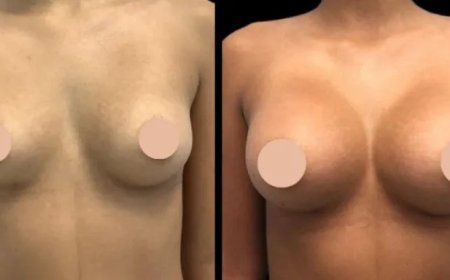What Are the Three Tests Used to Diagnose Lactose Intolerance?
Discover the three key tests for diagnosing lactose intolerance in the UK, including the lactose intolerance blood test, breath test, and elimination diet.

Struggling with bloating, stomach cramps or diarrhoea after drinking milk or eating cheese? You might be dealing with lactose intolerance. Its a common digestive issue in the UK, especially among adults, and yet, it often goes undiagnosed or misdiagnosed. Fortunately, modern medical testing can help identify it accurately. This blog explores the three main tests used to diagnose lactose intolerance, with a special focus on the lactose intolerance blood test, one of the most trusted diagnostic tools in the UK.
Understanding Lactose Intolerance: A Quick Refresher
Lactose intolerance occurs when your body doesn't produce enough lactase, the enzyme needed to digest lactosea sugar found in milk and dairy products. The undigested lactose ferments in the colon, causing uncomfortable symptoms such as:
-
Bloating
-
Wind or flatulence
-
Diarrhoea
-
Stomach pain or cramps
-
Nausea
The severity varies between individuals, but accurate diagnosis is essential before eliminating dairy from your diet.
The Three Common Tests for Diagnosing Lactose Intolerance in the UK
1. Lactose Intolerance Blood Test (Glucose Blood Test)
The most widely used and accessible test in the UK.
The lactose intolerance blood test measures how your body reacts after consuming a lactose-loaded drink. After ingestion, blood samples are taken at regular intervals to check your blood glucose levels.
-
How it works: If your body is producing enough lactase, the lactose gets broken down into glucose and galactose. This leads to a noticeable rise in your blood sugar levels.
-
Positive diagnosis: If there's no significant increase in blood glucose, it means lactose wasnt digested properlyindicating lactose intolerance.
? Why its preferred in the UK:
Its quick, safe, and relatively inexpensive. Many private clinics and NHS services offer this as a standard lactose intolerance test.
2.Hydrogen Breath Test
A non-invasive test thats also commonly offered by specialist clinics in the UK.
After drinking a lactose solution, your breath is analysed at regular intervals for hydrogen levels. When lactose isn't digested in the small intestine, it ferments in the colon and produces hydrogen, which is absorbed into the blood and eventually exhaled.
-
High hydrogen = poor lactose digestion
-
Test duration: Around 23 hours
-
Patient prep: Avoid antibiotics and certain foods 24 hours before
? Available at: NHS gastroenterology departments and allergy clinics across the UK.
3.Lactose Elimination Diet (Followed by Reintroduction)
Often recommended as a first-line diagnostic method in the UK.
You temporarily remove all lactose-containing foods from your diet for 2 to 3 weeks and observe whether your symptoms improve. Afterwards, you gradually reintroduce dairy to see if the symptoms return.
-
Simple but effective
-
Useful for self-monitoring
-
Recommended by UK dietitians and NHS GPs
? Important note: This test isnt definitive on its own and is usually used in combination with the lactose intolerance blood test or hydrogen breath test.
Choosing the Right Test: What Do UK Healthcare Providers Recommend?
In the UK, your GP may start with an elimination diet to check for improvements. However, if symptoms persist or if a more scientific confirmation is needed, they may refer you for a lactose intolerance blood test or a hydrogen breath test. These are typically conducted at:
-
NHS hospitals and outpatient departments
-
Private digestive health and allergy clinics
-
Specialist centres for gastrointestinal disorders
If you're unsure where to start, booking a consultation with a registered UK dietitian or private GP is a great first step. Many clinics now also offer walk-in lactose intolerance testing, especially in larger cities like London, Manchester, or Birmingham.
Benefits of the Lactose Intolerance Blood Test in the UK
Heres why many UK-based doctors recommend the lactose intolerance blood test:
? Fast Results: You can often receive same-day or next-day results
? Reliable and measurable: Offers an objective reading of how your body handles lactose
? Suitable for all ages: Especially useful for adults and children with persistent GI symptoms
? Easily available: Offered in many private health screening packages in the UK
Living with Lactose Intolerance: What's Next After Diagnosis?
Once you've been diagnosed, your GP or dietitian can help you manage your condition. In the UK, the NHS recommends the following:
-
Switch to lactose-free alternatives: Many UK supermarkets offer a wide range of lactose-free milk, yoghurts, and cheeses.
-
Consider lactase enzyme supplements: Available over-the-counter in UK pharmacies.
-
Keep a food diary: This helps identify your tolerance threshold.
-
Get your calcium and vitamin D: If youre cutting back on dairy, you might need supplements or fortified foods.
? Fun Fact: Some people with lactose intolerance can still tolerate small amounts of hard cheese, butter, or yoghurt, especially when consumed with other foods.
When to Seek Professional Help
If you're experiencing symptoms regularly after dairy consumption, don't ignore them. While lactose intolerance isn't dangerous, it can significantly affect your quality of life.
?? Consult your GP
?? Request a lactose intolerance blood test
?? Get referred to a registered dietitian
Undiagnosed lactose intolerance can mimic or coexist with other gastrointestinal issues like IBS, coeliac disease, or Crohns disease, so professional diagnosis is crucial.
Final Thoughts
Lactose intolerance doesnt have to control your lifebut to manage it properly, you need an accurate diagnosis. The three main tests used in the UKlactose intolerance blood test, hydrogen breath test, and elimination dieteach offer valuable insight into how your body responds to lactose.
By choosing the right test and working with qualified UK healthcare professionals, you can confidently adjust your diet, avoid unpleasant symptoms, and live a healthier, happier life.





































